Ground-Based Observations of Unusual Atmospheric Light Emissions
2014-12-14YANGJing杨静LUGaopeng陆高鹏DUJian杜艰andPANWeilin潘蔚琳
YANG Jing(杨静),LU Gaopeng(陆高鹏),DU Jian(杜艰),and PAN Weilin(潘蔚琳)
1 Key Laboratory of Middle Atmosphere and Global Environment Observation,Institute of Atmospheric Physics,Chinese Academy of Sciences,Beijing 100029
2 State Key Laboratory of Space Weather,Chinese Academy of Sciences,Beijing 100190
3 Collaborative Innovation Center on Forecast and Evaluation of Meteorological Disasters,Nanjing University of Information Science&Technology,Nanjing 210044
Ground-Based Observations of Unusual Atmospheric Light Emissions
YANG Jing1,2,3∗(杨静),LU Gaopeng1(陆高鹏),DU Jian2(杜艰),and PAN Weilin1(潘蔚琳)
1 Key Laboratory of Middle Atmosphere and Global Environment Observation,Institute of Atmospheric Physics,Chinese Academy of Sciences,Beijing 100029
2 State Key Laboratory of Space Weather,Chinese Academy of Sciences,Beijing 100190
3 Collaborative Innovation Center on Forecast and Evaluation of Meteorological Disasters,Nanjing University of Information Science&Technology,Nanjing 210044
Unusual atmospheric light emissions were observed from a station located in Shandong Province of East China.The main morphology of these events includes a bright glowing spot,which differs distinctly from any type of transient luminous events(TLEs)well recognized in literature,such as sprites,halos,elves,gigantic jets,blue jets,and blue starters.A comparison between the observations of four such light emission events and the data from lightning detection networks reveals no correlation between these events and the intense lightning activity in the adjacent area.The events reported in this paper may imply the existence of a new phenomenon with a mechanism that remains to be investigated with further observation and complementary lightning measurement.
transient luminous events(TLEs),lightning,thunderstorms
1.Introduction
Transient luminous events(TLEs)are brief optical emissions that occur above thunderstorms.Since the first TLE image was recorded on video by Franz et al.(1990),both ground-and aircraft-based observations have been conducted to understand the phenomenology and mechanisms of TLEs(Sentman et al.,1995;Lyons,1996;Su et al.,2002;Lyons et al., 2003;Hayakawa et al.,2004;Neubert et al.,2005; Ganot et al.,2007).The known types of TLEs include sprites,elves,halos,blue jets,blue starters,and gigantic jets(Sentman et al.,1995;Wescott et al.,1995, 1996,2001;Fukunishi et al.,1996;van der Velde et al.,2007;Cummer et al.,2009;Soula et al.,2011; Lu et al.,2013).Yair et al.(2005)reported a single event known as Transient Ionospheric Glow Emission in Red(TIGER),with morphology substantially different from common TLEs.In this paper,we report four events of unusual atmospheric light emissions observed from a station located in the midlatitude area of East China.The morphology of the events appears as bright spots,which differs from any TLEs that are well recognized in previous literature.
2.Data description
Sprite observation wasconducted in Zhanhua CountyShandong Province of East China(Yang et al.,2008).The observation system consists of a Watec 902H2 Supreme low-light-level camera(set to a high gain of 0.0003 lux×F1.4)equipped with a 12-mm f/0.8 computar lens;the field of view(FOV)of the imaging system is
31.1°(H)by 21.2°(V).Data from the camera are recorded at 25 frames(each with two interlaced fields) on the computer hard disk;thus,the time resolution of the image sequence is 20 ms.The time corresponding to the start of each image field is derived from the Global Positioning System(GPS).UFO(unidentified flying object)capture software is generally used for detecting events with brightness in excess of a certain threshold and for replaying the features of their spatial and temporal development.
Supported by the National(Key)Basic Research and Development(973)Program of China(2014CB441405),Specialized Research Fund for State Key Laboratory of Space Weather,Collaborative Innovation Center on Forecast and Evaluation of Meteorological Disasters,National Natural Science Foundation of China(41374153 and 40804028),Beijing Natural Science Foundation (8143038),and Youth Innovation Promotion Association of the Chinese Academy of Sciences.
∗Corresponding author:yangj@mail.iap.ac.cn.
©The Chinese Meteorological Society and Springer-Verlag Berlin Heidelberg 2014
Two types of data are used to provide time and location information of lightning activity,which include local lightning location network in Shandong and Henan provinces and World Wide Lightning Location Network(WWLLN).Shandong Province Lightning Detection Network provides lightning information for the selected storms in 2007 and on 20 July 2010.For the storm occurring on 25 July 2010,the lightning data were provided by Henan Province Lightning Detection Network,which uses similar location technology as that of the United States National Lightning Detection Network.The network consists of 10 very low-frequency sensors and one data processing center and uses combined time-of-arrival(TOA)and magnetic-direction-finding(MDF)technologies(Cummins et al.,1998).The data from this network were used for the analysis of lightning activity in the thunderstorms of interest.The WWLLN data were used for real-time target selection to locate centers of electrical activity and determine the azimuth of camera pointing.
In addition,the meteorological satellite data of Japan Meteorological Agency(JMA)were downloaded from the JMA website (http://weather.is.kochiu.ac.jp/archive-e.html)for analysis of cloud characteristics every hour at a spatial resolution of 0.05°× 0.05°.Detailed information of the storms was also obtained by using the Doppler radar data provided by Shandong Meteorological Bureau and Henan Meteorological Bureau.Moreover,space weather data have been checked as well on the dates of reported events to rule out the possibility that the observed events were caused by brief illuminations of Charge-Coupled Device(CCD)pixels due to impacts of energetic particles from solar events or geomagnetic activity.
3.Results and discussion
In this section,we present the analysis of four atmospheric light emission events that were observed in 2007 and 2010.The event in 2007 is examined in Section 3.1 to show that the observed event was not related to aircrafts,satellites,twinkling of stars,or meteors,suggesting that the observed spot-like events may likely be unusual atmospheric light emissions.Three more events recorded in 2010 are analyzed in Section 3.2 to demonstrate variability in the morphologies of these events.The possible mechanism associated with this type of spot-like events is investigated and discussed in Section 3.3.
3.1 Event on 2 August 2007
A thunderstorm developed to the southwest of the observation site during the late night of 1 August 2007. This storm displayed several features of mesoscale convective systems(MCSs),which are known as the most productive thunderstorm systems of sprites.These features include a relatively long lifetime(>10 h) and a large spatial scale(around 200 km;Yang et al., 2013).Between 2130 BT(Beijing Time)1 and 0143 BT 2 August,16 sprites were recorded above the thunderstorm(Yang et al.,2008),one of which is shown in Fig.1a.
Approximately 2 h after the last sprite observation on 2 August 2007,an additional triggering event was recorded at 03:34:12 BT(Fig.1b).Figures 1c and 1d show the cloud-top brightness temperature with cloud-to-ground(CG)lightning within±30 min centered at 0300 and 0400 BT 2 August 2007,respectively. The red and white dots in Figs.1c and 1d mark positive and negative CG flashes,respectively.The red lines represent the range of the line-of-sight extending from the observation site,i.e.,the field of view of the camera.The camera orientation in Figs.1c and 1d was the same.The event appeared as a bright spot that remained visible for nearly 200 ms,as shown by the time sequence images of this event(Fig.2a).
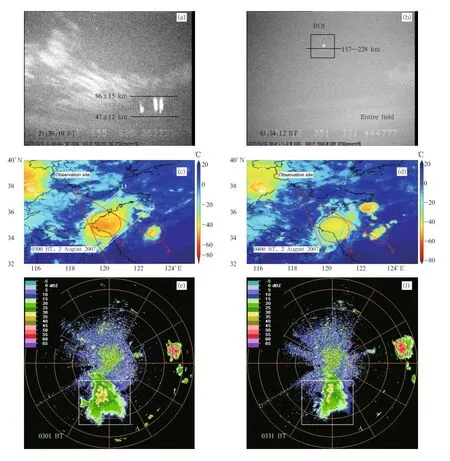
Fig.1.(a)A columniform sprite observed at 21:30:10 BT 1 August 2007,for which no parental cloud-to-ground (CG)lightning was detected.(b)A spot-like event recorded at 03:34:12 BT 2 August 2007.(c,d)Cloud-top brightness temperature on 2 August 2007,with CG lightning within±30 min centered at 0300 and 0400 BT in(c)and(d), respectively.The red and white dots in(c)and(d)mark positive and negative CG flashes,respectively.The red lines represent the range of the line-of-sight extending from the observation site,i.e.,the field of view of the camera.The camera orientation in(c)and(d)was the same.The white lines in(c)denoted as L1 and L2 represent the near and far edges of the thunderstorm.(e)and(f)show the Doppler radar images at the times of interest.
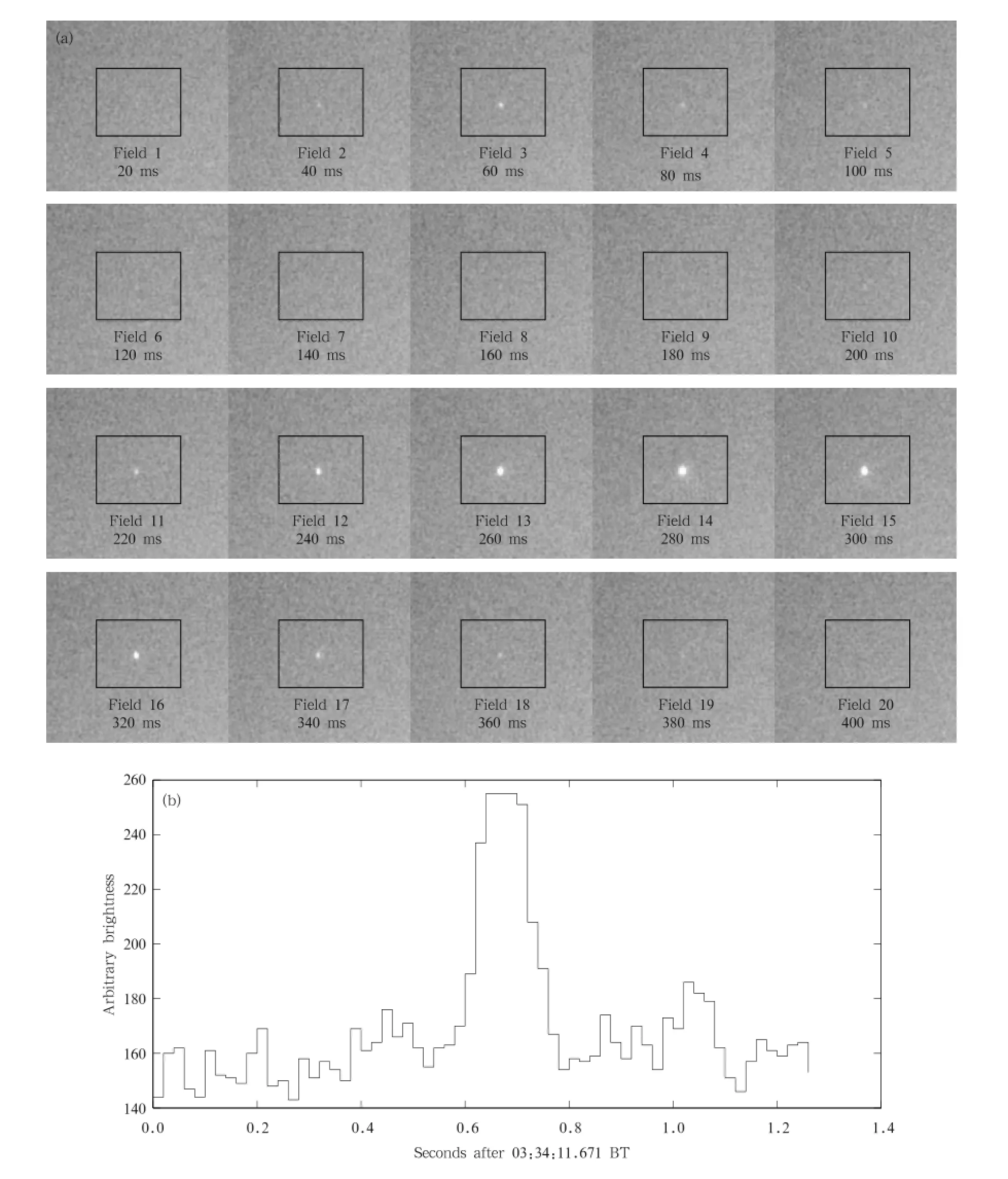
Fig.2.(a)Sequential image fields of the transient luminous event recorded at 03:34:12 BT 2 August 2007,in the region of interest(ROI)in Fig.1b.The frame rate is 25 frames s-1,with each frame further separated into even and odd image fields at 20-ms time intervals.(b)The center arbitrary brightness of the ROI versus time.
Assuming that the event in Fig.2 was produced by a thunderstorm in the FOV of the camera,the altitude and dimension of the event could be estimated on the basis of the horizontal distance from the observation site(the camera location)to the thunderstorm edge and camera viewing angle.By using the observation site as a reference point,two horizontal distances from the storm are produced.The first is from the observation site to the near edge of the storm,labeled L1 in Fig.1c,and the second is to the far edge,labeled as L2 in Fig. 1c. According to this analysis,the altitude and dimension of this event are constrained to 157-228 km and(36×39)-(51×56)km2,respectively,based on the assumption that the spot-like event was produced above the storm.It should be noted,however,that if the event was not related to
the storm,the location in the upper part of the image can indicate a very close-range event,which is not very high.The storm developed mainly above open water, according to the infrared satellite images(Figs.1c and 1d).To obtain additional information,Doppler radar data with a scanning range of 230 km were used to determine storm characteristics,as shown in Figs.1e and 1f.It can be seen that most of Storm B was outside of the radar scanning range.Because only a very small part of Storm B was in the camera field view, the possibility of the event produced by this storm was ruled out,as will be discussed at the end of this section.Therefore,Storm B did not significantly affect the results.The Doppler radar images show that Storm A at the approximate distance was very weak at the time of the event occurrence,which was responsible for the very few lightning flashes in Figs.1c and 1d.Storm A at 0400 BT was even weaker(figure omitted).
The event resulted in one trigger on the imaging system,which ruled out the possibility of an aircraft entering the FOV of the camera.Otherwise,the duration of observation would be at least a few seconds,and a series of triggers would have been present. Moreover,this event appeared as one bright spot that only remained visible for approximately 200 ms over the 1.26-s span of observation;thus,it did not appear to be a star or a satellite flying in the FOV of the camera.To further rule out the possibility of an Iridium-class satellite,which has a unique property of reflecting surfaces manifested as flickering,observations with the same camera and set-up were conducted for several days.During this period,no thunderstorms were present in the camera view field,and the sky was very clear with some stars clearly visible.During the observation,many videos of airplanes were recorded, the flight directions of which were also clearly visible. However,no similar events were recorded.
Moreover,we ruled out the possibility of a meteor flying parallel to the camera’s line of sight because,as shown in Fig.2,the event appeared in the first four fields(80 ms),then became invisible in the subsequent six fields(Fields 5-10;120 ms)and appeared again in Fields 11-18.It should be noted that the location of the event in the camera view field did not change during Fields 1-18;a meteor would have been visible in Fields 5-10.The event was not likely blocked by clouds in the camera view field during Fields 5-10 because the arbitrary brightness and size of the event in the camera field did not change substantially,as shown in Fields 2 and 11.
As shown in Figs.1c and 1d,Storm B is much smaller compared with Storm A.Centered at approximately 34°N,123°E,Storm B was partially located inside the FOV of the camera during the observation of this event.It is not likely that the observed event was produced by this storm because otherwise,the event would have appeared near the left edge of the FOV of the camera.
3.2 Events in July 2010
Three additional events with similar features to that examined in Section 3.1 were recorded in July 2010,indicating that the occurrence of the event in 2007 was not accidental,which is true at least in the vicinity of our observation site.The analysis results of two events on 20 July and one event on 25 July,including the estimated altitude and duration,are shown in Table 1.
The two events occurring on 20 July were likely both over open water,and the event on 25 July was over land,provided that the events had relationships with the storms underneath. The altitudes of the events(Figs.1,3-5)observed in this study were very
similar because they appeared in the upper part of the camera view field.The possibility of meteors flying parallel to the line of sight of the camera located at similar altitudes in the view field is very small.In
addition,Fig.5 shows that the event developed downward in Field 2 and that the lower part of the event resembled a tail,which further rules out the connection of meteors with the observation reported here.

Table 1.Characteristics of four spot-like events
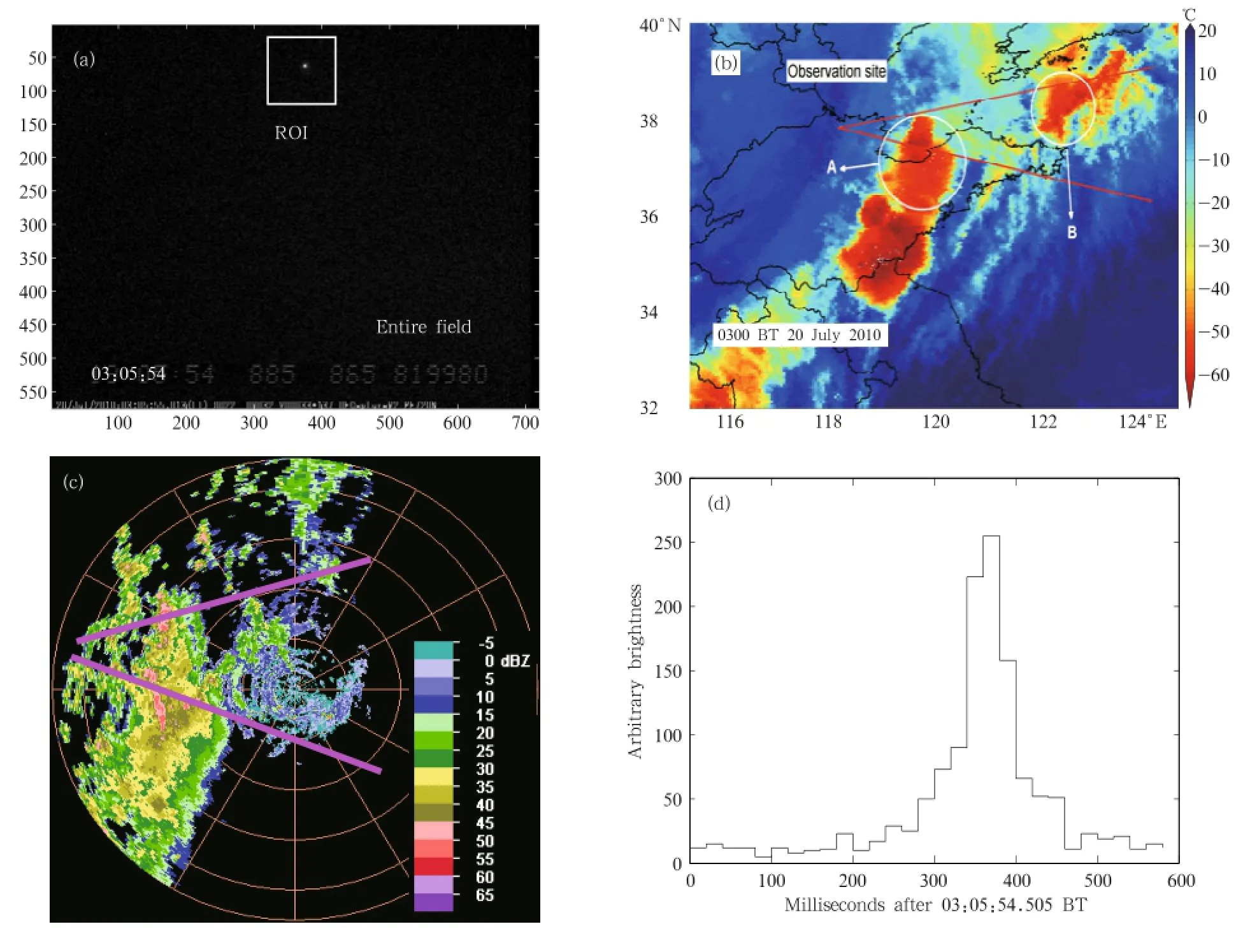
Fig.3.(a)The event recorded at 03:05:54 BT 20 July 2010.(b)Cloud-top brightness temperature on 20 July 2010, with cloud-to-ground(CG)lightning within±30 min centered at 0300 BT(red dots,white dots,and red lines are the same as those in Fig.1c).(c)Doppler radar image of the storm.(d)Center arbitrary brightness of the ROI versus time.
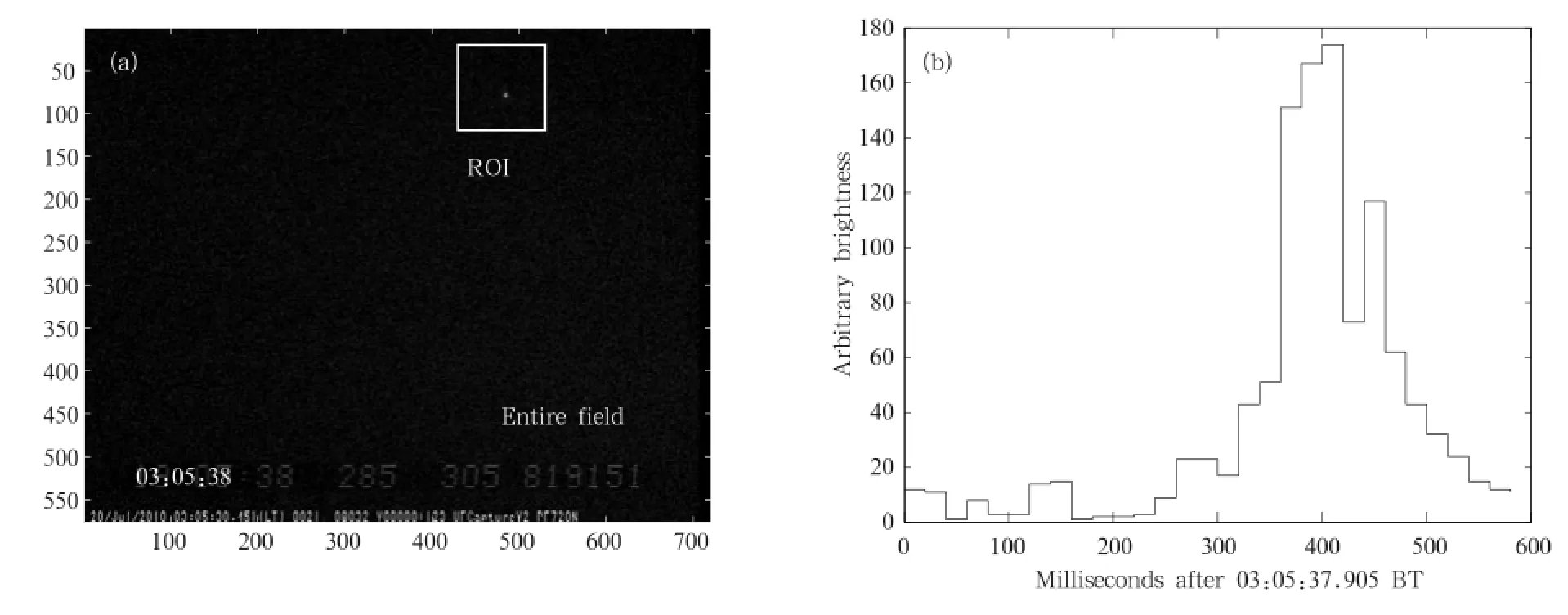
Fig.4.(a)The event recorded at 03:05:38 BT 20 July 2010 and(b)center arbitrary brightness of ROI versus time.
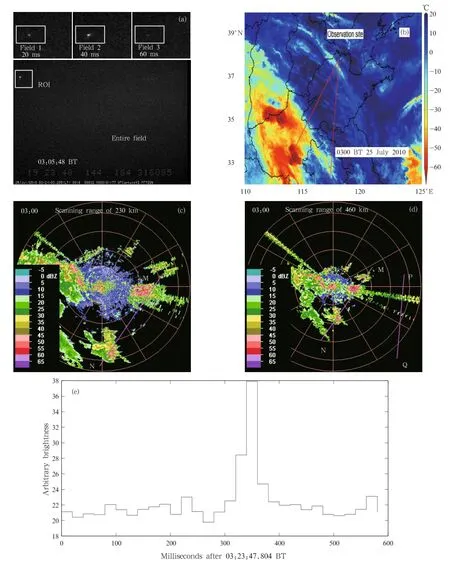
Fig.5.(a)The event recorded at 03:23:48 BT 25 July 2010.(b)Cloud-top brightness temperature on 25 July 2010, with cloud-to-ground(CG)lightning within±30 min centered at 0300 BT(red dots,white dots,and red lines are the same as those in Fig.1c).(c)and(d)Doppler radar images of the storm.(e)Center arbitrary brightness of the ROI versus time.
The center arbitrary brightness of the ROI(region of interest)versus time was similar in the four events,as shown in Figs.2-5.No unusual energetic events were reported on 20 and 25 July 2010.Although an energetic electron particle event related to a radiation belt occurred on 2 August 2007,it is nearly impossible for the energetic particles to reach such low altitudes because the electron mass is very small,and the particles reached geosynchronous orbit,which is much higher than 150 km.In addition,the illumination on the CCD caused by energetic particles would be a bright dot and would not flicker.Therefore,the chances of the events being caused by energetic particles are very small.The discussions above indicate that the observations reported here are not associated with aircraft,star,satellite,meteor,or energetic particles;instead,they are likely the manifestation of a new phenomenon.
3.3 Possible mechanism of the observed events
We then attempted to determine whether these events were related to lightning or a thunderstorm. Figures 1c and 1d show the distribution of CG flashes superimposed on Multifunctional Transport Satellite (MTSAT)hourly cloud-top brightness temperature in the early morning of 2 August 2007.The red dots and white dots mark positive and negative CGs,respectively,within 1 h centered at the time shown in the figures.The figures show that few flashes occurred in the camera FOV;the flashes shown were obtained by combining return strokes into one single flash.That is,successive return strokes were considered to be one flash if their time intervals and horizontal distances were smaller than 0.5 s and 10 km,respectively.Considering that the combining algorithm used here may be subject to some uncertainty,the return strokes(not flashes)were superimposed directly on the cloud-top brightness temperature maps(figure omitted).Few return strokes were still detected in the camera FOV.
By meticulously comparing this information with data from the lightning location network,one negative flash was detected 14.32 s prior to the event,although this flash was located in the direction opposite that of the camera orientation,or in the upper left-hand corner of the storm in Figs.1c and 1d.Therefore,no parent CG was detected for the light emission event at 03:34:12 BT 2 August 2007.The discussions above indicate that the event may have occurred without a distinct relationship with tropospheric lightning activity.Similar analysis was made for the events recorded in July 2010.No return strokes occurred in the camera FOV in these cases either,which further indicates that the event may not have been associated with lightning. However,although both of the local lightning location systems and WWLLN have detection efficiency,the fact that no lightning detected by these two types of lightning location systems was found for the events does not absolutely mean that these events were not related to lightning.
To obtain more information,Doppler radar images with a scanning range of 230 km were used to determine the characteristics of the storms in July 2010.Figure 3c shows that comparatively strong radar echoes of Storm A and weak echoes of Storm B were in the camera view field;the two pink lines in Fig.3c represent the camera FOV.The negative CG lightning flashes in Fig.3b were associated with the strong radar reflectivity.For the event on 25 July 2010,Doppler radar images are shown in Figs.5c and 5d with radar scanning ranges of 230 and 460 km,respectively.The camera FOV is not completely shown in Fig.5c but is completely shown in Fig.5d.The radar images show that only a small part of the strong radar echo was in the camera view field and that very few lightning flashes occurred,which may not indicate a strong correlation between the recorded events and the lightning activity in the area.
Yair et al.(2005)reported an event known as TIGER with morphology that differed from common TLEs.The TIGER event was almost horizontal in image,while three of the four events in this paper were like a spot and one of the events even had some vertical development.Yair et al.(2005)pointed out that
the possible generation mechanism for TIGER may include the conjugated sprite hypothesis caused by lightning at the magnetic mirror point,lightning-induced electron precipitation,and an extraterrestrial source. Our observations of the spot-like events do not resemble any known class of TLEs found in previous literature,including the TIGER event in Yair et al. (2005).The lightning activity determined by using the WWLLN data and the particle beams in the magnetic conjugate points were also checked for the four events in this paper,although neither phenomenon was detected.
Cohen et al.(2010)reported that a beam of relativistic electrons could produce a lightning discharge. Whether the events reported here were atmospheric optical radiation induced by electron beams is an open question that requires further investigation with both coordinated observations and numerical simulations. Because the detection efficiency of WWLLN is not very high,electron beams caused by lightning may not be detected.Moreover,the mechanism in which millisecond-scale electron beams can induce optical emissions of more than ten to hundreds of milliseconds remains unknown.The events reported here are not linked to thunderstorms or flashes.Therefore,further observations are desired to accumulate additional cases for revealing the mechanism of this phenomenon.
4.Conclusions
Four unusual atmospheric light emission events were analyzed in this paper. The morphologies of these events differed from any known types of TLEs described in previous literature.Possibilities of these events being aircraft,satellite,stars,or meteors were excluded.A comparison between the observed events and the data from lightning detection networks do not indicate a correlation of these events with CG lightning in the same region.The events may be a phenomenon with an underlying physical mechanism to be revealed with further coordinated lightning and thunderstorm observations.
Acknowledgment.The first author is grateful to the support provided by Nanjing University of Information Science&Technology.
Cohen,M.B.,U.S.Inan,R.K.Said,et al.,2010:A lightning discharge producing a beam of relativistic electrons into space.Geophys.Res.Lett.,37,doi: 10.1029/2010GL044481.
Cummer,S.A.,J.B.Li,F.Han,et al.,2009:Quantification of the troposphere-to-ionosphere charge transfer in a gigantic jet.Nature Geosci.,2,617-620.
Cummins,K.L.,M.J.Murphy,E.A.Bardo,et al., 1998:A combined TOA/MDF technology upgrade of the U.S.National Lightning Detection Network. J.Geophys.Res.,103(D8),9035-9044.
Franz,R.C.,R.J.Nemzek,and J.R.Winckler,1990: Television image of a large upward electrical discharge above a thunderstorm system.Science,249, 48-51.
Fukunishi,H.,Y.Takahashi,M.Kubota,et al.,1996: Elves:Lightning-induced transient luminous events in the lower ionospohere.Geophys.Res.Lett.,23, 2157-2160.
Ganot,M.,Y.Yair,C.Price,et al.,2007:First detection of transient luminous events associated with winter thunderstorms in the eastern Mediterranean.Geophy.Res.Lett.,34,doi:10.1029/2007GL029258.
Hayakawa,M.,T.Nakamura,Y.Hobara,et al.,2004: Observation ofspritesoverthesea ofJapan and conditionsforlightning-induced spritesin winter. J.Geophys. Res.,109(A01312),doi: 10.1029/2003JA009905.
Lu,G.,S.A.Cummer,J.B.Li,et al.,2013:Coordinated observations of sprites and in-cloud lightning flash structure.J.Geophys.Res.,118,6607-6632,doi: 10.1002/jgrd.50459.
Lyons,W.A.,1996:Sprite observations above the U.S. High Plains in relation to their parent thunderstorm systems.J.Geophys.Res.,101,29641-29652.
—-,E.R.Williams,S.A.Cummer,et al.,2003:Characteristics of sprite-producing positive cloud-to-ground lightning during the 19 July 2000 STEPS mesoscale convective systems.Mon.Wea.Rev.,131,2417-2427.
Neubert,T.,T.H.Allin,E.Blanc,et al.,2005:Coordinated observations of transient luminous events during the EuroSprite 2003 campaign.J.Atmos. Sol.-Terr.Phys.,67,807-820.
Sentman,D.D.,E.M.Wescott,D.L.Osborne,et al., 1995:Preliminary results from the Sprites94 aircraft campaign.1:Red sprites.Geophy.Res.Lett.,22, 1209-1212.
Soula,S.,O.Van der Velde,J.Montanya,et al.,2011: Gigantic jets produced by an isolated tropical thunderstorm near R´eunion Island.J.Geophys.Res., 116(D19103),doi:10.1029/2010JD015581.
Su,H.T.,R.R.Hsu,A.B.Chen,et al.,2002:Observation of sprites over the Asian continent and over oceans around Taiwan.Geophys.Res.Lett.,29, doi:10.1029/2001GL013737.
Van der Velde,O.A.,W.A.Lyons,T.E.Nelson,et al., 2007:Analysis of the first gigantic jet recorded over continental North America.J.Geophys.Res.,112, doi:10.1029/2007JD008575.
Wescott,E.M.,D.D.Sentman,D.Osborne,et al., 1995:Preliminary results from the Sprites 94 aircraft campaign.2:Blue jets.Geophys.Res.Lett., 22,1209-1212.
—-,D.D.Sentman,M.J.Heavner,et al.,1996:Blue starter:Brief upward discharges from an intense Arkansas thunderstorm.Geophys.Res.Lett.,23, 2153-2156.
—-,H.C.Stenbaek-Nielsen,D.D.Sentman,et al.,2001: Triangulation of sprites,associated halos and their possible relation to causative lightning and micrometeors.J.Geophys.Res.,106,10467-10477.
Yair,Y.,C.Price,B.Ziv,et al.,2005:Space shuttleobservation ofan unusualtransientatmospheric emission. Geophy. Res. Lett.,32,doi: 10.1029/2004GL021551.
Yang Jing,Qie Xiushu,Zhang Guangshu,et al.,2008: Red sprites over thunderstorms in the coast of Shandong Province,China.Chinese Sci.Bull.,53,1079-1086.
—-,—-,and Feng Guili,2013:Characteristics of one sprite-producing summer thunderstorm. Atmos. Res.,127,90-115,doi:10.1016/j.atmosres.2011.08. 001.
:Yang Jing,Lu Gaopeng,Du Jian,et al.,2014:Ground-based observations of unusual atmospheric light emissions.J.Meteor.Res.,28(4),624-633,
10.1007/s13351-014-3086-7.
(Received December 31,2013;in final form April 21,2014)
猜你喜欢
杂志排行
Journal of Meteorological Research的其它文章
- Spectrum Analysis of Wind Profiling Radar Measurements
- Applications of an AMSR-E RFI Detection and Correction Algorithm in 1-DVAR over Land
- Tracking the Moisture Sources of an Extreme Precipitation Event in Shandong,China in July 2007:A Computational Analysis
- Gust Front Statistical Characteristics and Automatic Identification Algorithm for CINRAD
- Diagnostic Study of Global Energy Cycle of the GRAPES Global Model in the Mixed Space-Time Domain
- Characteristics of Meteorological Factors over Different Landscape Types During Dust Storm Events in Cele,Xinjiang,China
